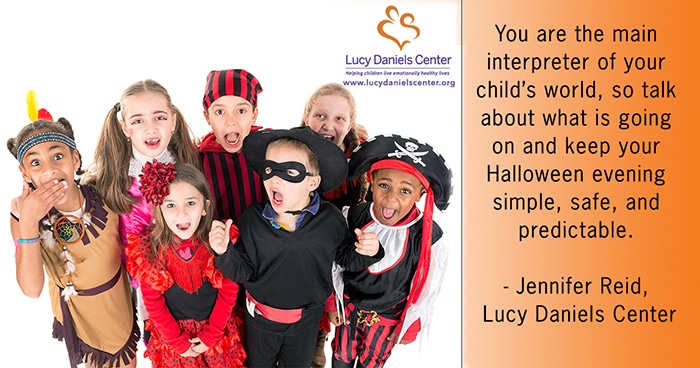How do you know what kind of costume is right for your child? Considering your child’s age – and how dependent they are upon you to provide feelings of safety – may help you make a more informed choice.
For young children, dressing up is a form of imaginative play. In play, children explore various roles (such as pretending to be a parent caring for a baby or a police officer capturing bad people). In moments of true play, these roles may feel quite real to young children as they attempt to conquer the good and bad that exists both in the real world as well as their internal world. Thinking about how much your child invests in this type of play, as well as how much he or she depends on you for feelings of safety (or reality checks), can help you determine what type of costume is right for your child.
18 months/two years old and younger
Most children under 18 months have not yet developed a true capacity to engage in pretend play, and therefore, dressing up has little, if any, meaning to them. Having a costume put on at this age is no different from being dressed in an everyday outfit. Their play consists primarily of exploring their surroundings through their senses – the sights, sounds, smells, tastes, and textures of their world. Children in this age group depend completely on their parents and caregivers for feelings of safety. Keep Halloween short and sweet for this age group – there is a lot for the senses to process on this vibrant night of the year.
Two – five years old
Children in this age group have moved beyond solely exploring and are beginning to integrate their surroundings with their expanding minds. They are organizing data and developing an understanding of why and how things work in the world. Children in this age group rely on their caregivers to help them learn about their world, and they often take what they are learning and explore it in their imaginative play. The boundaries between play and reality can sometimes become blurred for children in this age group. (Think, for example, of the child who becomes frightened when the “bad guys” are chasing him and needs a break from the play.) Helping your child choose a costume that feels good and safe will help ensure that your child feels good and safe throughout the evening. Appropriate costumes for sensitive children in this age group include community helpers, fairytale characters, or superheroes who are good-natured.
Six years old and older
Children six and older have developed a clearer sense of what is real and what is pretend. Around this age, you can begin to shift the costume decision to your growing child. Designing and making your own creative costumes together can become a fun and engaging pre-Halloween activity. As children grow older and into their early teen years, wearing costumes on Halloween moves beyond the simple fun of dressing up and turns into an outlet for individual expression.
Lastly, be available to your young children on this exciting night of the year, repeating throughout the evening that costumes are just costumes. While some of the activities on Halloween are restricted this year, children will likely still see many costumes and decorations. Scary surprises may be fun for older children but can quickly become too frightening for the young child who still has fuzzy boundaries between reality and fantasy. Remember that you are your child’s main interpreter of the world, so talk about what is going on and keep your evening simple, safe, and predictable.

